Battle for Donbass. Breakthrough Mius-front. Part of 5
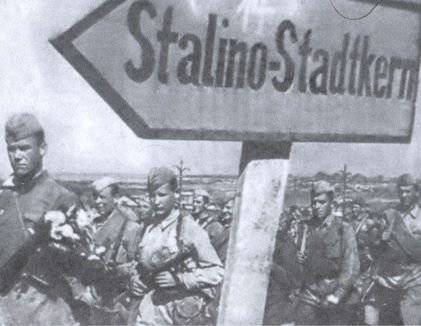 The end of the operation of the Southern Front
The end of the operation of the Southern FrontAs a result of the defeat of the southern flank of the Donbass group of the Wehrmacht (Taganrog grouping) in its defense from Donetsk-Amvrosiyevka to the coast of the Azov Sea, a wide gap was formed. The German command had neither the strength nor the time to close it. The operational reserves of Army Group South were largely consumed. Soviet troops continued the offensive, and there was a chance that the Red Army would go into the flank and rear of the Donbass group. At the same time, the forces of the Voronezh and Steppe fronts continued their offensive on the Belgorod-Kharkov direction and, moving westward, hung over the Donbas group of German armed forces from the north. For the German troops in the Donbass there was a threat of encirclement and complete destruction.
The German command took measures to delay the advance of the troops of the Voronezh and Steppe fronts and at the same time began the withdrawal of troops from the Donbass. The German military leadership wanted to organize the withdrawal of troops to previously prepared positions, impose a positional struggle on the Red Army and retain a significant part of Ukraine. On August 31, Adolf Hitler gave permission to the commander of Army Group "South" Manstein to begin the withdrawal of the 6th Army and the right flank of the 1st tank army. At the same time, a "Directive on the evacuation, destruction and removal of property" was sent out in parts. The Germans wanted to destroy the important infrastructure of the Donbass region. During the retreat, German troops used scorched earth tactics. “Desert Zones” were supposed to slow down the advance of the Red Army and give time to create a powerful defensive line on the Dnieper River. At the same time, the Germans carried out a massive theft of Soviet citizens, especially young people and men of military age.
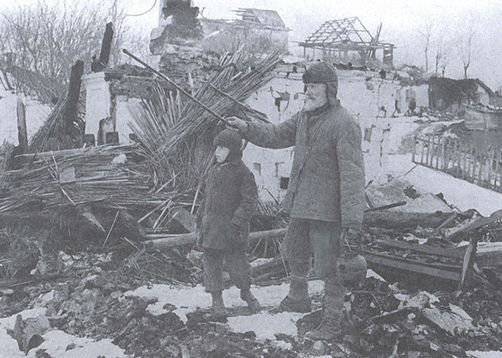
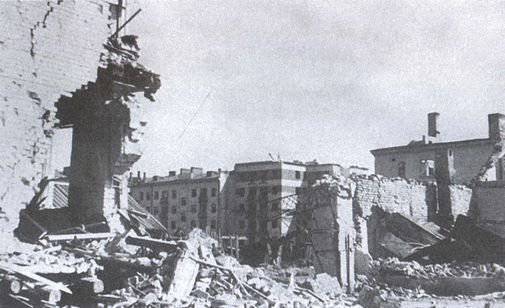
The German command wanted to withdraw the troops in a planned manner, gaining time for the export of material values (robbery) and the destruction of cultural, industrial, social and agricultural facilities. In addition, it was necessary to gain time to prepare the main defensive line on the Dnieper and Molochnaya rivers. For this, several intermediate, auxiliary lines of defense were created, since the area favored the defending side: numerous rivers, rivers, ravines, a chain of heights going in the meridional direction. Natural obstacles were strengthened in engineering. The basis of the defensive lines were the nodes of resistance, strongholds into which the settlements were turned, heights. The departure of troops was carried out by marches from one defensive line to another at a distance of about 25 km from each other. Usually, before the withdrawal of the main forces, the Germans carried out strong artillery attacks, machine-gun fire on the Soviet positions, counterattacks with forces up to a battalion reinforced with tanks. Created the appearance of a dense defense.
The troops withdrew under the cover of night, they were covered by strong rearguards. Their composition ranged from company to battalion, which were reinforced by several tanks and assault guns, anti-tank battery, 4-5, 75-mm guns, armored personnel carriers. Sometimes an important area covered rearguard reinforced 15-20 tanks. German rear guards occupied defenses on a broad front, controlling heights, river banks and settlements. Created resistance nodes. In between, small mobile teams operated. Strong fire resistance, maneuvering guns and tanks, the Germans tried to create the appearance of a dense defense. At night, the rear guard on the machines retreated to a new frontier, hiding behind machine-gun points, groups of machine gunners and "roaming" gun crews. The remaining groups conducted continuous fire, changing positions, creating the appearance of preserving the line of defense. To slow down the advance of the Red Army forces, the Germans created debris on the roads, mined them, mined ferries, gati, bridges, blew them up, burned settlements, drove the population.
The Soviet command carried out the pursuit of the enemy by vanguards and forward detachments, which each division distinguished. Avant-garde usually consisted of a rifle regiment, reinforced by divisional and anti-tank artillery. With a slight resistance of the enemy in this direction, the forward detachment consisted of a rifle battalion, reconnaissance company, sappers, regimental and anti-tank artillery batteries, and anti-tank rifle units. There were also mobile pursuit groups. They included from the company to the battalion of shooters, a battery of light guns, several mortars, tanks and self-propelled guns. The southern front began the pursuit of enemy forces 1 September, and the troops of the left wing of the Southwestern Front - 2 September 1943 year.
6-I German army, despite serious losses, was a serious opponent. At the end of August, it was replenished with new formations, and it consisted of 14 divisions (11 infantry and 3 tank), 18 separate battalions. The army received the task to retreat to the defensive line on the right bank of the r. Dairy and firmly close the approaches to the lower reaches of the Dnieper River and the Crimea. Prior to this main line of defense there were several intermediate ones. The most powerful line of defense passed through Makeyevka to Konstantinovka, east of Stalin and further south along the Kalmius river. He defended Stalino (Donetsk) - the key city of the Donbass region. This milestone was called the "Turtle Position". She was hastily built by the “Todt organization” (the military construction organization of the Third Reich), army sappers, and herded the local population. The German command planned to hold the “Turtle position” for quite a long time. One of the means that was supposed to help the 6 Army to hold the "Turtle position" was the battalion of tanks "Panther". He arrived at the disposal of General Hollidt in early September. The Panther battalion was transferred to the 17 Army Corps.
But the hopes of the German command to hold onto the "position of the Turtle" were in vain. The southern front received reinforcements. In August, the Orlovsky ledge was liquidated, the German troops retreated under the “Hagen line”. The front was shortened, the 11 tank corps was transferred to the Southern Front. In late July and early August, the 11 tank corps fought in the 4 tank army in the Orel region. September 7 The 11 Tank Corps was brought into combat in the direction of Volnovakha, in the center of the construction of the 6 of the German army. The defense of Hollidt’s army lost its stability.
In addition, in early September, the Law Faculty launched an offensive on the right flank — the 51 Army was attacking under the command of General J. G. Kreizer. At the end of August, the army was reinforced with the 10 rifle corps of General KP Neverov from the North Caucasus Front. The corps included 216, 257, and 328 rifle divisions. On the night of September 1, 1943, the Army Intelligence, determined that the enemy was leaving. The 257 Rifle Division occupied Shterovka, turned by the Germans into a strong stronghold. By the end of September 2, the Kraiser armies had crossed the Mius-front on a broad front, its last defenses had fallen. By the end of September 3, army units of the 51 Army marched westward to 60 kilometers and freed more than a hundred settlements, including the city of Voroshilovsk. September 7 army occupied Ocheretino. The Kraiser army posed a threat to the right wing of the 1 tank army and the left flank of the 6 army. The German command deployed the 9 Tank Division and the 209 Battalion of assault guns to the Ocheretino area. However, it was already impossible to change the situation. In the evening of September 7, the 6 Army under the command of Hollidt received an order to withdraw from the "Turtle position", it lasted only a few days on it. Mius-front was finally broken through and remained in the rear of the Red Army.
Closely interacting with the army of Kreyzer, the 5-I shock army came under the command of V. D. Tsvetaev. She attacked her left flank - the 9 rifle corps, which was included in the army at the end of August. For the first two days of the offensive, Soviet troops liberated Snezhnoye, Chistyakovo, Zuevka and a number of other settlements. In the center of the offensive line of the army of Tsvetaev, units of the 34, 40 of the Guards and 320 of the rifle divisions, which received the task of taking Enakievo, moved. Previously they had to capture several strongholds of the enemy. By the morning of September 3, the forward detachment of the 40 Guards Rifle Division had overtaken an enemy convoy, which was moving to Enakievo. As part of the Soviet avant-garde was 170 fighters, the detachment was reinforced by three 76-mm guns, four 45-mm guns, two 82-mm mortars, six anti-tank guns, two machine guns. The stronger enemy did not have time to turn around, and was completely crushed. The Germans lost about 250 people killed, 2 field guns and 18 vehicles were destroyed, 5 vehicles were taken, 18 field guns, 4 mortars, 12 machine guns. Soviet soldiers captured 135 man prisoners. Then the forward detachment broke into the north-eastern outskirts of Enakiev. At the same time, the forward detachments of the 34-th Guards Rifle Division and the 320-th Rifle Division entered the settlement. Attacked from three directions, the Germans were forced to retreat. All three divisions received the honorary title "Enakievsky". The troops of the 5 shock army continued their advance deep into the Donbass.
2-I Guards Army G. F. Zakharova regrouped forces and reached the line Kuteynikovo - Pokrovsky. The German command forces 9-th tank and 258-th infantry divisions organized a counterattack. 31 August was fierce battles, the Germans pressed the 87-th Guards Rifle Division. The Soviet command pulled artillery units of rifle corps on the flanks of the enemy wedge. At the same time, the connections of the 2 Guards Mechanized Corps were brought up to the battlefield from the south, and from the north they were part of the 33 Guards Rifle Division of the 1 Guards Rifle Corps. From the air, Soviet troops were supposed to support 200 attack aircraft and bombers. Was created a kind of fire bag. On September 1, the enemy forces were subjected to artillery and air strikes; units of the 2 Guards Mechanized Corps and 33 Guards Rifle Division were hit on the flanks. German troops, having suffered serious losses, began to hastily retreat beyond the river. Kalmius.
The 28 Army by the end of September 1 reached the line of the river Dry Elanchik. For three days, the army of the army of V.F. Gerasimenko successfully advanced until they were stopped at the turn of the r. Kalmius. The 44 Army under the leadership of V. A. Khomenko, pursuing the remnants of the enemy’s Taganrog grouping along the Azov Sea coast, reached the eastern coast of Kalmius and Mariupol by the end of September.
Manstein, without waiting for the divisions promised to him at the end of August, 3 September went to the headquarters of the Supreme Commander in East Prussia. The commander of Army Group "South" again asked Hitler for reinforcements. Manstein believed that the main danger for the Wehrmacht was in the Donbass and it was necessary to transfer forces from other sectors of the front here. However, Field Marshal Kluge, commander of the Army Group Center, has already informed Hitler of a serious aggravation of the situation on the central sector of the Eastern Front. The Red Army went over to the offensive on other sectors of the Eastern Front. In addition, 3 September Italy left the war, Berlin had to urgently strengthen the troops in the Italian direction. From France to the Apennines transferred several divisions that could be sent to the Eastern Front. The command of Army Group "South" had to do on its own. It is also necessary to take into account the fact that the replenishment of the divisions of Army Group South was of worse quality than the previous troops. In addition, the Wehrmacht morale, after the failure of the operation "Citadel", fell seriously. The aura of invincibility of the Wehrmacht was finally dispelled.
By the end of September 3, the troops of the 51 Army defeated the enemy forces in the area of Debaltsev. Developing the offensive, the army occupied several settlements south of Krasnoarmeisk. The 5 shock army broke the enemy’s resistance at the Gorlovka-Makeevka-Stalino line. The connections of the 126 Rifle Division by the beginning of Colonel A. I. Kazartsev and the 271 Rifle Division by Colonel I. P. Govorov released Gorlovka (they received the honorary names Gorlovka). The city was captured significant stocks of military property. By the end of September 6, Soviet troops liberated Makeyevka. Fighters of the 54 Guards Rifle Division, General M.M. Danilov, distinguished themselves in battle, she received the honorary title “Makeevskaya”. By the morning of September 7, forward detachments of the 5 Shock Army started a battle on the northern approaches to Stalino and on the eastern outskirts of the city. The battle for the city was fought by units of the 230 Infantry Division under the leadership of Colonel A. A. Ukrainian, 301 Infantry Division of Colonel VS Antonov and 50 of the Guards Rifle Division of Colonel A. S. Vladychansky. At night the city was liberated. Divisions received the honorary title of "Stalinist".
While the 5-I shock army captured Gorlovka, Makeyevka and Stalin, the 2-I Guards army fought at the Kalmius line, in the Starobeshev area. The troops of the 28 Army prepared for the breakthrough of the German positions on the r. Kalmius. In the 16 hours of September 7, after the 30-minute artillery preparation, the army launched an offensive. The 11 th Panzer Corps of General HH Radkevich and the 5 Guards Don Cossack Cossack Corps of General A. G. Selivanov were to be included in the breakthrough. In the 18 watch, the tank corps began to force the river, in the first echelon, the 65-I and 136-I tank brigades marched. On September 8, forces of the 11 and 12 of the Cossack Cavalry divisions forced the river. The enemy was able to organize a strong counterattack, the Soviet troops almost dropped into the river. Chief of Staff of the Southern Front, General S. S. Biryuzov was able to organize a repulse. The Germans left the "Turtle position" and tried to gain a foothold at the turn, which took place approximately 10 km west of the Kalmius River. However, they could not. German troops began to retreat to the "crocodile position". She stretched from Mariupol harbor to the north-west in the direction of the Greater Yanisol.
The German troops, retreating, continued to cling to each locality. Especially fierce fighting turned around for Volnovakha. This important railway junction allowed for the transfer of troops by rail to the north - towards Stalin, to the south - to Mariupol, to the west - to Dnipropetrovsk. Therefore, the defense of the settlement was carried out by units of the 3 th mountain infantry, 17 th infantry, 17 th tank divisions and other units. Despite the serious forces that defended the city, and the fierceness of the resistance, the Germans could not hold the city. 10 September The Red Army liberated the city. His release was carried out by the troops of the 2 Guards Mechanized Corps, the 11 Tank Corps of the 5 Guards Don Cavalry Corps.
At the same time there were fierce battles in the area of Mariupol. Here the units of the 221 th and 130 th rifle divisions of the 44 th army were advancing. The German command, attaching great importance to Mariupol, which was a major port and the center of the metallurgical and machine-building industry, created a powerful line of defense here, called by them "Mius-2". On the right bank of the Kalmius River, all the heights were fortified, a lot of pillboxes, pillboxes, dugouts and artillery positions were created. The 111 th, 336 th infantry divisions and several separate battalions defended here. 8 and 9 September, the Soviet troops launched an offensive several times, but did not achieve significant success. The Germans went to violent counterattacks. Some villages passed from hand to hand several times. The turning point in the battle occurred only 10 September.
Azov military flotilla landed two landings to the west of the city. On September 8, a company of the 384th Separate Marine Battalion, under the command of Lieutenant K.F. Olshansky, was landed near the village of Yalta. The paratroopers had to intercept the coastal highway. The Marines destroyed the enemy coastal firing points, and successfully operated in the German rear during September 8–10. When the Germans were able to block the detachment, the company made its way to the outskirts of Mariupol. Another company of marines landed on the night of September 10 in Melekin. The landing party, led by Captain-Lieutenant V.E. Nemchenko, broke into the village and destroyed the garrison - about 200 Romanian soldiers, two batteries of 130-mm and 45-mm guns. The blow was so sudden that the detachment lost only 3 people wounded. Then the marines captured the village of Peschanoe. At dawn, the Germans pulled up reinforcements, but the landing, at the cost of the death of the cover group - 13 machine gunners, escaped from the strike and made its way to Mariupol. By lunchtime, the paratroopers captured the port. The Germans launched a counterattack and pushed the Soviet soldiers to the shipyard. There, the Marines took up a circular defense. They held out until the arrival of the Olshansky landing force and the advanced units of the 44th Army. September 10, Mariupol was liberated from enemy troops. Soviet soldiers recaptured the train with young people who were prepared for shipment to the German Empire, seized a lot of property prepared for export and destruction. For the liberation of Mariupol, the 130th Taganrog Rifle Division was awarded the Order of the Red Banner.
After the breakthrough of the German line of defense on the Kalmius River, in essence, the liberation of Donbass in the action zone of the troops of the Southern Front was completed. German troops hastily retreated to the west. Soviet troops developed an offensive in the general direction of Gulyai-Polye. By the end of September 16, Gulyai-Pole was freed from the enemy. The 16-20 of September, units of the 6 Army retreated to the “Wotan” position — along the west bank of the Chingul and Molochnaya rivers, between Melitopol and the Dnieper arc south of Zaporozhye. By September 20 our troops reached this line, but they could not break through with it. The southern front halted the offensive, preparing for the implementation of a new offensive operation. As a result, by September 20, the troops of the Southern Front completed an operation to clean the Donbass from the enemy troops.
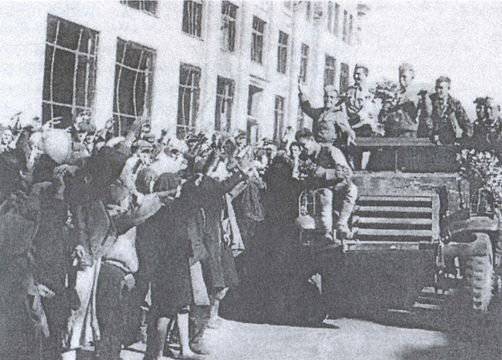
Liberators meets the population.
The successes of the South-Western Front
Simultaneously with the troops of the Southern Front, they were advancing from the forces of the South-Western Front. The front occupied a section of the front along the left bank of the Seversky Donets River, which is more than 300 km long. Here the defense was held by the German 1-I tank army commanded by Eberhard von Mackensen. By 1 September 1943, she had 10 divisions, including one tank and one motorized. In early September, German troops began to withdraw in the general direction of Dnipropetrovsk and Zaporizhia. The first intermediate defense line was the Slavyansk-Kramatorsk-Konstantinovka area. The departure was accompanied by an active artillery-mortar cannonade.
The first to launch the offensive was the 3-I Guards Army under the command of General D. D. Lelyushenko. September 1 commander gave the order to form in the composition of the divisions of mobile units. On the same day they began pursuing the enemy. On the night of September 2, units of the 32 Infantry Corps, which was located on the left flank of the army, crossed the river in the area of Lysychansk. By the end of the day, the units of the 279 Infantry Division of General VS Potapenko occupied Lisichansk (the division received the honorary name “Lisichanskaya”). September 3 troops 3-th Guards Army completely freed from the enemy Voroshilovgrad region.
The Germans created a powerful defense at the turn of Slavyansk and Kramatorsk. However, the Soviet troops, overcoming the fierce resistance of the enemy, liberated several settlements during the 5 of September, including the city of Artyomovsk. The 266 and 259 rifle divisions received the title of "Artyomovsk". The success of the 3 Guards Army began to develop with the help of the 33-th rifle and 23-th tank corps. Until that time, they were part of the 6 Army. Also, the 1-th Guards Mechanized Corps (arrived from the 8-th Guards Army), the 7-th Artillery Breakthrough Division, two Guards Mortar Regiments and the 47-th engineering brigade were sent to the breakout site.
The strike of mobile units came at the junction between the 1-th tank and 6-th armies, so it turned out to be very successful. September 5 The 23 th Panzer Corps of General E. G. Pushkin broke into Konstantinovka. On the night of September 6, the city was liberated from enemy forces. Particularly distinguished themselves in the liberation of the city 135-I tank brigade and 179 th anti-tank artillery regiment, they were called "Konstantinovskie". At the same time, the 1 Guards Mechanized Corps of General I. N. Russiyanov liberated the city of Druzhkovka. On September 6, units of the 34 Guards Rifle Corps liberated Slavyansk and Kramatorsk. As a result, the troops of the 3 Guards Army by the end of September 6 advanced west on 75 – 100 km. September 7 The 23 tank corps liberated Krasnoarmeysk. By 9 September, the 3-I Guards Army advanced westward to 150 – 180 km, freeing settlements near 700. Since September 8, the other front armies also launched an offensive. On the morning of September 10, the 8-I Guards Army liberated Barvenkovo.
On September 11, German troops launched a counterblow, trying to cut off the forces of the 23 Tank and 1 Guards Mechanized Corps that had broken far to the west from the main forces of the front. For several days violent battles took place. German counterattack repulsed. By September 16, units of the 3 Guards Army reached the Chaplino area, and the units of the 6 Army liberated Lozovaya. Manstein, after the failure of the idea of "mobile defense", September 15 ordered the withdrawal of troops for the Dnieper and Molochnaya. The rate of advance of the troops of the South-Western Front accelerated. By September 22, front-line troops on the left flank and in the center reached the Novomoskovsk line east of Zaporozhye, and on the right flank reached the Dnieper River by the end of the month. In fact, this Donbas operation was completed.
Results
- The July offensive of the Southern and South-Western Fronts deprived the command of Army Group South for the reserves needed to carry out Operation Citadel and forced Manstein to withdraw the divisions from the direction of the main attack. Thus, the troops of the Southern and Southwestern Fronts took part in the victory in the Great Battle of Kursk, which completed the strategic turning point in the war.
- In August, the troops of the Southern Front broke through the powerful German defenses on the Mius Front, liberated Taganrog, defeated the 29 German Corps. The German command was forced to begin withdrawing troops in the direction of the Dnieper. In September, the forces of the Southern and Southwestern Fronts completely liberated the Donets Basin from enemy forces. The Red Army advanced 300 km and entered the Dnepropetrovsk-Melitopol line. The road was opened through the Northern Tavria to the Crimea and to the lower reaches of the Dnieper. The success of the troops of the Southern and South-Western fronts contributed to the victory of the Voronezh and Steppe fronts over the Belgorod-Kharkov enemy grouping.
- The German command was forced to evacuate the 17 Army to the Crimea, leaving the Kuban. Germany lost Donbass - the most important economic center. The Soviet Union strengthened its economic opportunities in the coal industry, metallurgy, engineering and agriculture.
Sources:
Vasilevsky A.M. A matter of a lifetime. - M., 1978. // http://militera.lib.ru/memo/russian/vasilevsky/index.html
Zhirokhov M. Battle of the Donbass. Mius-front. 1941-1943. M., 2011.
Isaev A.V. Liberation 1943. "From Kursk and Orel, the war brought us ...". M. 2013.
Manstein. Lost victories. M., 2002.
G.Puzhaev. Blood and Glory of Mius. M., 2008.
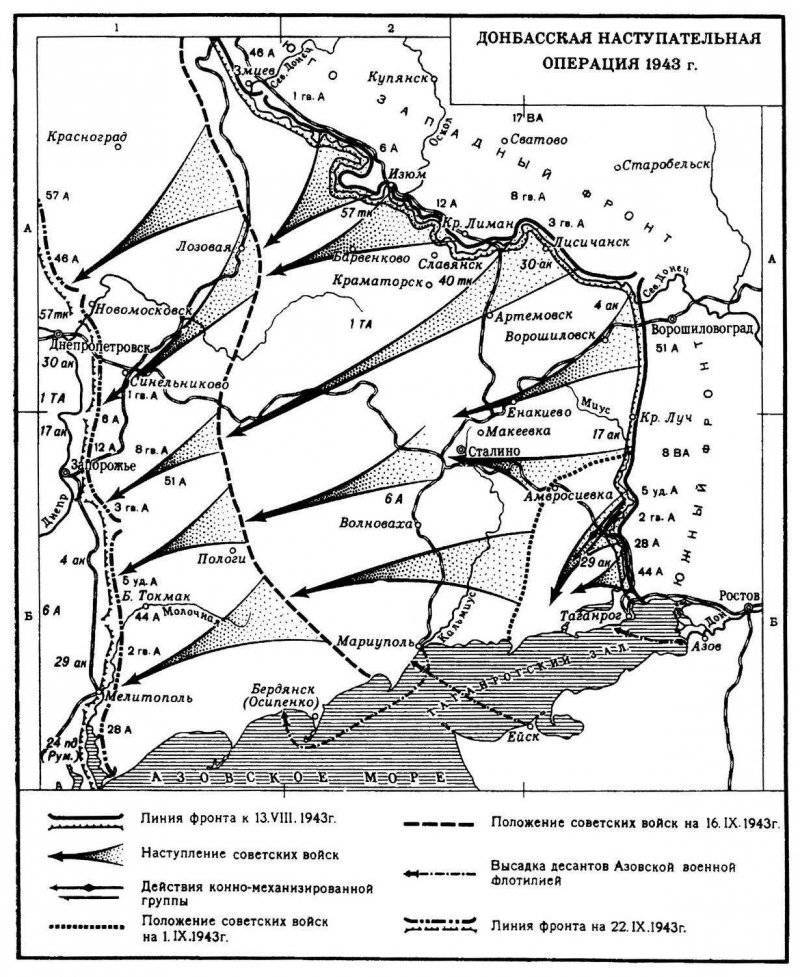
Information